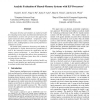Free Online Productivity Tools
i2Speak
i2Symbol
i2OCR
iTex2Img
iWeb2Print
iWeb2Shot
i2Type
iPdf2Split
iPdf2Merge
i2Bopomofo
i2Arabic
i2Style
i2Image
i2PDF
iLatex2Rtf
Sci2ools
ISCA
1998
IEEE
1998
IEEE
Analytic Evaluation of Shared-memory Systems with ILP Processors
This paper develops and validates an analytical model for evaluating various types of architectural alternatives for shared-memory systems with processors that aggressively exploit instruction-level parallelism. Compared to simulation, the analytical model is many orders of magnitude faster to solve, yielding highly accurate system performance estimates in seconds. The model input parameters characterize the ability of an application to exploit instruction-level parallelism as well as the interaction between the application and the memory system architecture. A trace-driven simulation methodology is developed that allows these parameters to be generated over 100 times faster than with a detailed execution-driven simulator. Finally, this paper shows that the analytical model can be used to gain insights into application performance and to evaluate architectural design trade-offs.
| Added | 05 Aug 2010 |
| Updated | 05 Aug 2010 |
| Type | Conference |
| Year | 1998 |
| Where | ISCA |
| Authors | Daniel J. Sorin, Vijay S. Pai, Sarita V. Adve, Mary K. Vernon, David A. Wood |
Comments (0)

